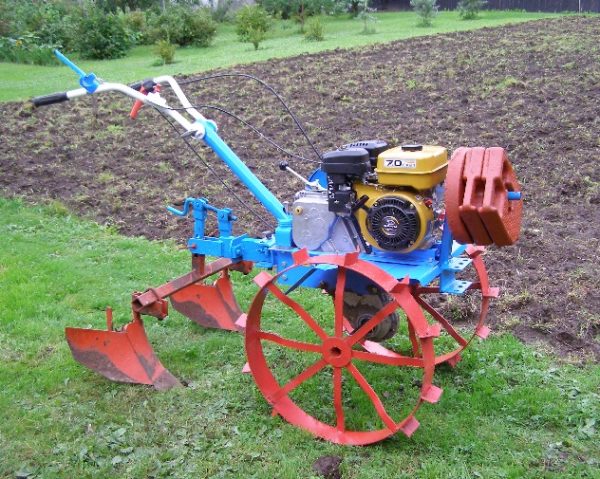
Planting potatoes using a walk-behind tractor has proved itself not only as an effective way, but also as an opportunity for a gardener to save his time and energy. Since planting potatoes is one of the most labor-intensive processes, gardeners have always looked for methods that help ease work, using various inventions of scientific and technological progress. For example, in a garden area of 5 acres, you can work with a shovel all day. If you start using special equipment, then you can deal with this matter within a couple of hours. However, despite the fact that there can be many models and varieties of agricultural technology, the principle of working with them is almost the same.
Nevertheless, such a technique has its drawbacks. One of them is that only a man can control the equipment. In addition, for the normal functioning of such tools, it is necessary to acquire additional details, since this will contribute to improving the operation of equipment.
Content
How to choose an okuchnik
Today, there are several types of hills for planting with a walk-behind tractor, and each of them makes it easier to carry out the procedure for planting potatoes. In addition, each model has its own individual characteristics. The most popular is currently considered to be a hiller with a fixed breadth of girth. The capture latitude in it is standard, about a third of a meter, and it is impossible to change it. It is perfect for hilling vegetables like tomatoes or cucumbers, however, there will be little distance for planting potatoes.
In addition, gardeners also use disk hillers, which among others are considered the most expensive. Disks that are part of the overall design can be adjusted, that is, change the angle of their inclination. This affects the quality of planting potatoes, which when using this model is significantly increased. With the help of disk hillers, the process of preparing the soil for further planting is simplified. In addition, this hiller is very convenient to use, so gardeners prefer to use this particular model.
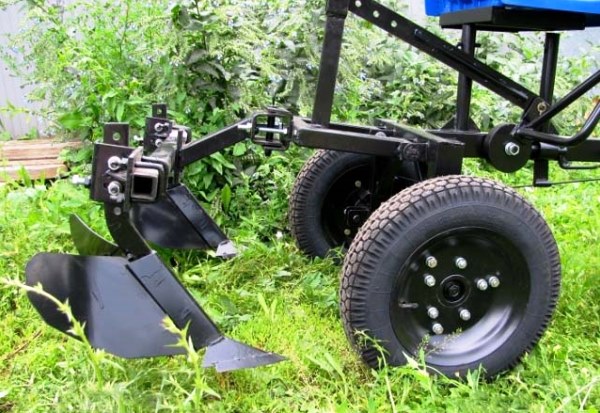
Experienced gardeners often use disc spouts because they are easy to use. Cutting furrows does not require special work, and it will also save a lot of time. In addition, you can also save money, since its cost is quite affordable.
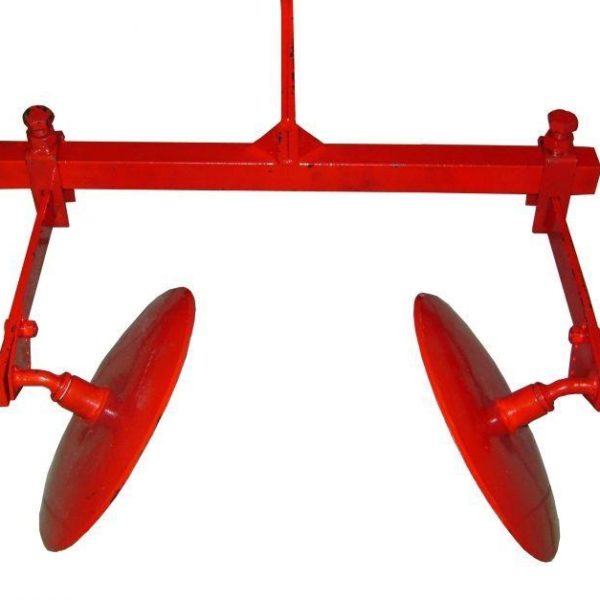
Land cultivation
Before planting potatoes directly, do not forget to till the ground; it should be soft and loose. You can use the standard method and do it with a shovel, but to save your time, use mills that must be attached to the technique. The speed and quality in this case is ensured.
As a rule, the Niva motoblock is used, which is considered the most common in use by gardeners. This technique is notable for its unpretentiousness and reliability. It can regularly serve its consumer for several years. Cultivation in this case must be carried out at a second speed. Start work from the very edge of your garden plot. When you reach the end of the area, treat two meters perpendicular to the furrows. Then we perform the same actions on the other side of the site.
After that, we begin to cultivate the territory along the beds. When you use milling cutters, it is necessary to go the same milling cutter along the path left earlier on the way back, since they make small indentations in the ground. In this case, the soil will be processed to the depth of the bayonet, which will be the highest quality cultivation of the earth. If you do not carry out the milling cutter along the same track that it had previously left, then the depth is significantly reduced, and this complicates the further planting of potatoes.
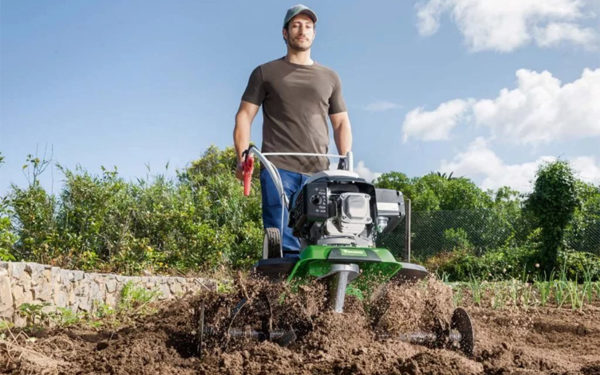
If you cultivate a plot along the beds, the plowing is smooth. Rakes need to level the ground only in those places where the equipment was unfolding.
Motoblock preparation
The technique with which you will cultivate the land and prepare it for planting potatoes also needs some preparation for the process itself. Remove the cutters from the technique and install the lugs. You can independently reconstruct the walk-behind tractor yourself, since the whole process does not seem too complicated. Metal pins are inserted into the construction of the equipment, after which a two-row hiller is installed. You can immediately adjust the distance. It will be enough to set the row spacing equal to 65 cm.
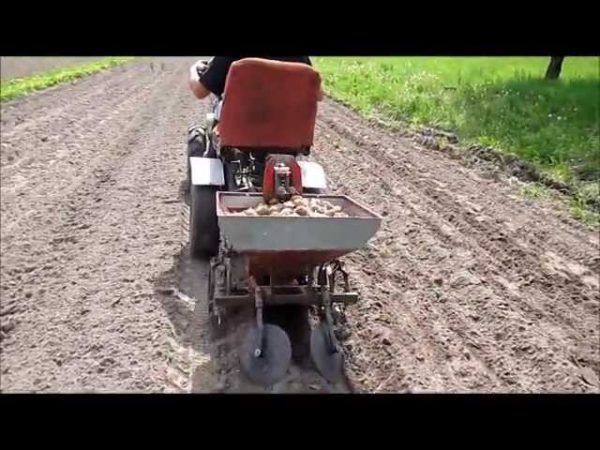
Planting potatoes with a walk-behind tractor using a two-row hiller
Once you have prepared the soil, you can proceed directly to planting potatoes. Slip metal extensions onto the lugs and replace them with milling cutters. After that, we remove the emphasis in the center from the walk-behind tractor and attach the hitch to this place. Then we hook and thread metal pins, and then we already hook the hiller onto the structure. We set the necessary distance between the hills, which will be equal to the width between adjacent beds.
Using the hitch, you can change the location of the hiller using a special handle, after which we turn around and go in the opposite direction. Having completed this process, we can begin to plant potatoes. We throw the pre-processed tubers into the cleared beds, trying to keep them at a distance of about 40 cm. The tubers should be treated with special solutions against parasitic bacteria and insects in order to protect the plant and not risk losing crop. Once you have planted potatoes, you need to fill it up. To do this, we increase the width of the wings at the hiller, which the design of the equipment allows. We turn on the first speed and fill up the potatoes with soil on it.
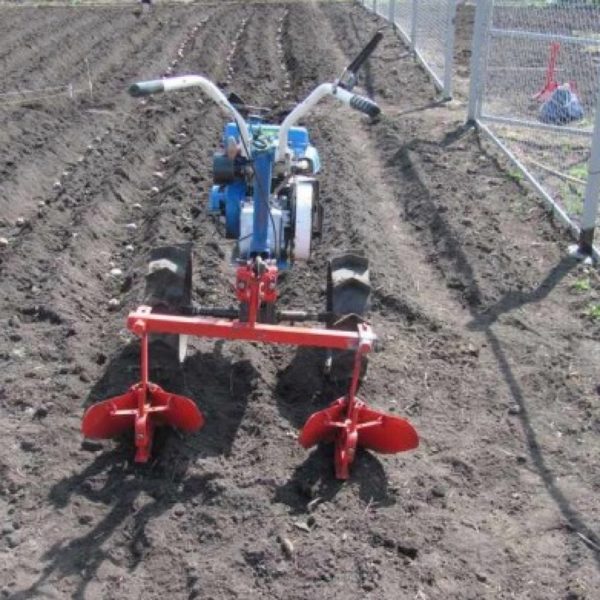
Planting potatoes with a plow
The plow is usually used before the onset of the first frost in order to plow the land on the threshold of winter. In this case, there is no need to mark the garden with lines. First, we cut the furrow with one plow. After that, you will need to immediately throw the potato into the excavated space. Once you have completed this procedure, you need to turn the cultivator. We put the extreme wheel directly on the bed. The earth from the newly cut furrow heaps up the potatoes placed in the beds.
In this case, the lug may accidentally hurt the potatoes themselves, but there is nothing to worry gardeners. Gradually, in this way, we plant all the beds in order at first speed. And so we cut one bed and at the same time fill up the next one. The beds using this principle come out more smoothly, since the wheel of the device goes along the already cut furrow.
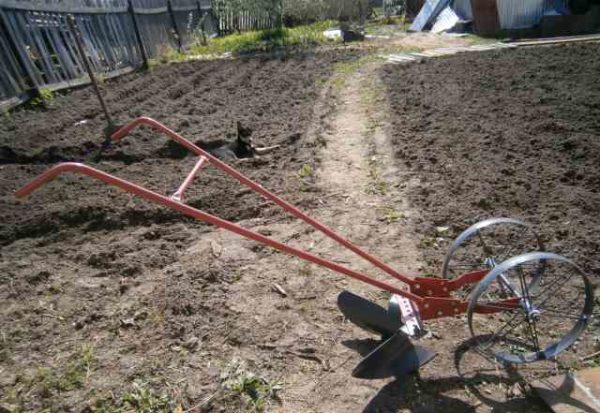
Reviews
Different gardeners have a different impression of using a walk-behind tractor. Some argue that the use of potato planters is easier for them, it is convenient to use. As consumers say, ease of management for them is one of the highest priority points in the operation of this technology. Gardeners also pay great attention to universality, as a potato planter digs, plants at the same time, and then safely buries potatoes in the ground. After such a procedure, there is practically no need to spend extra time on leveling the ground.
Many gardeners say that not even an innovative technique can significantly simplify the planting of potatoes. For example, even the old Neva can speed up the process and make the beds more even. This technique is very convenient and really saves time spent on landing.




 Description and description of varieties in Belarus with a photo
Description and description of varieties in Belarus with a photo Do I need to pick flowers from potatoes: why do they do it
Do I need to pick flowers from potatoes: why do they do it When to dig potatoes: timing and availability of new potatoes
When to dig potatoes: timing and availability of new potatoes How to grow a good potato crop: various methods and methods, planting and care
How to grow a good potato crop: various methods and methods, planting and care
Vladimir
Hello!
My name is Vladimir, I represent the Mirs information and advertising network (mirs.com). I wanted to offer you to monetize the traffic https://en.tomathouse.com/4/ with the help of our Marketguide project informers.
Let's discuss the details?